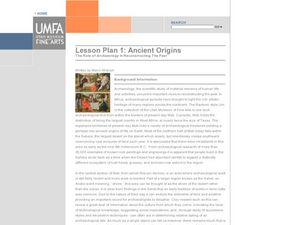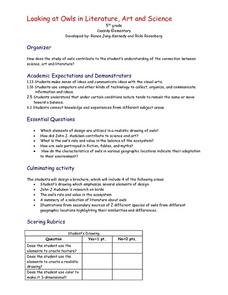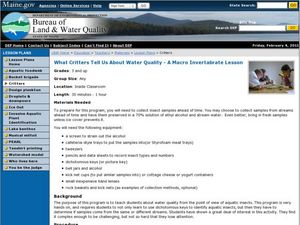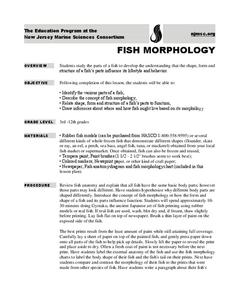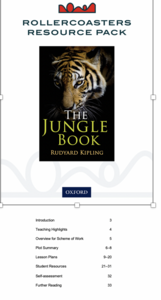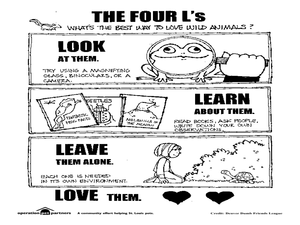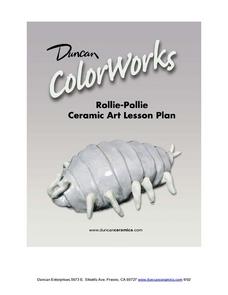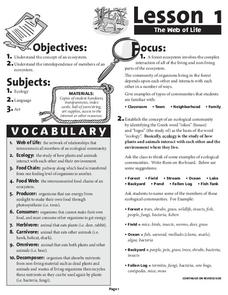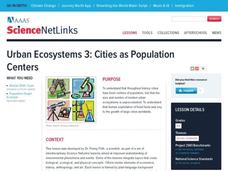Curated OER
Information Fluency Unit
Fourth graders, after defining the task and searching for some creative strategies, role play being a Park Ranger who tries to save Big Bend from being removed from the National Park system in Texas. They support the keeping of Big Bend...
Curated OER
Koi Pond
Students engage in a creative project of making a paper koi pond meant to illustrate the type of life that can be found in the pond ecosystem. They build cultural appreciation for the Japanese by researching the use of the koi ponds.
Curated OER
Talking Trees
Students investigate the ecosystem. In this environmental lesson, students read the book The Tree by Dana Lyons and list ways to save the trees. Students create a poster about saving the trees.
Curated OER
Ancient Origins: The Role of Archaeology in Reconstructing the Past
Learners read information about the ancient origins of art and archaeology with a focus on the Malian culture. In this art origins lesson, students read background information for the topic and compare ancient and contemporary objects....
Curated OER
Everybody Needs a Little Sunshine
Three activities introduce upper elementary ecologists to photosynthesis and food webs. In the first, an experiment is set up to determine how plants respond to different types of light. In the second, they connect organism cards with...
Curated OER
What Is El Niño?
Students access information at remote sites using telecommunications, identify impacts by reviewing past El Ni??o events, make and use scale drawings, maps, and maps symbols to find locations and describe relationships.
Curated OER
Potential Consequences of Climate Variability and Change
Students examine the potential impact of climate change to agriculture, coastal areas, forests, water, and human health. They hypothesize what might happen to a sugar maple forest and hold a debate about global warming.
Curated OER
Looking at Owls in Literature, Art, and Science
Fifth graders investigate the characteristics of owls through various science and art activities. They analyze drawings by J.J. Audubon and complete a Venn diagram comparing the similarities and differences of different kinds of owls,...
Curated OER
What Critters Tell Us About Water Quality: A Macroinvertebrate Lesson
Learners explore our ecosystem by investigating the quality of our water. In this aquatic insect instructional activity, students examine a group of random insects collected from different streams and ponds in the area. Learners record...
Curated OER
Art of Biodiversity
Young scholars familiarize themselves with values of biodiversity. They comprehend that biodiversity has inspirational and cultural values. Students locate five works of art on Zoo grounds that represent biodiversity in some way.
Consortium for Ocean Science Exploration and Engagement (COSEE)
Fish Morphology
Life comes in all different shapes and sizes, and fish are no exception. Here, young scientists create fish prints as they learn how specific characteristics allow different species to survive in their particular habitats.
Reed Novel Studies
Flush: Novel Study
Standing up for beliefs sometimes leads to trouble! The father in Flush takes knows this all too well when he sinks a boat in protest to its illegal dumping. With his dad behind bars, the son, Noah, takes matters into his hands by...
Oxford University Press
The Jungle Book
Most every teacher dreams of a ready-to-teach and print book study. Well, here it is! The Jungle Book novel resource includes 12 complete lessons studying poetry, author's craft, themes, characters, and more. Scholars role play,...
EngageNY
Introduction: The Ideas of Charles Darwin
Piece by piece ... Scholars read the text World without Fish by breaking the text into pieces. They identify challenging words and determine the gist of each section as they read. They then work together in triads to answer...
EngageNY
Close Reading and Gathering Evidence from Frightful’s Mountain and “Welcome Back”
Where did the falcons go? Scholars read the article Welcome Back which describes the disappearance of falcons due to the use of pesticides. During a second read, learners annotate the text by marking unfamiliar words and facts about...
Curated OER
Imagine a Kelp Forest
Young scholars write a story based on their research of the kelp forest. In this ecosystem lesson, students view a video and research the kelp forest ecosystem. They write a short story imagining the discovery of a new species in the...
Curated OER
Wonderfully Wild Unit the four L's of Wildlife
Students appreciate the natural environment. In this "four L's" lesson, students observe, reflect and appreciate unique ecosystems and how they help sustain life. Students create posters with the four L's.
Curated OER
A Tree is a Friend
Fifth graders discover the value of trees in our society. In this ecosystem instructional activity, 5th graders read the book, A Tree is Nice, and discuss with classmates how trees are essential to our existence due to creating...
Curated OER
Art to Zoo: Celebration
Learners research and develop a report on birthday rituals around the world. In this research lesson plan, students compare birthday rituals from other cultures to their own. Images and resources are included.
Curated OER
Rollie-Pollie - - Ceramic Art
Pupils are introduced to a variety of sculpting techniques: rolling, pinching and scoring. They practice utilizing additive and subtractive processes in making simple sculptural forms to depict bugs. Each student also interprets...
Curated OER
High And Dry
Students explore the similarities and differences between desert environments and their local environment. After examining desert scened painted by Georgia O'Keeffe, they discuss the elements of their desert landscapes. Students use...
Forest Foundation
The Web of Life
Producers, herbivores, carnivores, omnivores, decomposers. To begin a study of the forest ecosystem, learners examine the connections among the members of ecological communities.
Curated OER
Urban Ecosystems 3: Cities as Population Centers
Young scholars discover that throughout history cities have been centers of population but that human exploitation of fossil fuels was key to the growth of large cities worldwide. They research urban growth through a number of websites.
Forest Foundation
Forests, Carbon & Our Climate
To conclude their examination of forest ecosystems, class members consider the role forests play in the carbon cycle and how forests can offset climate change.





